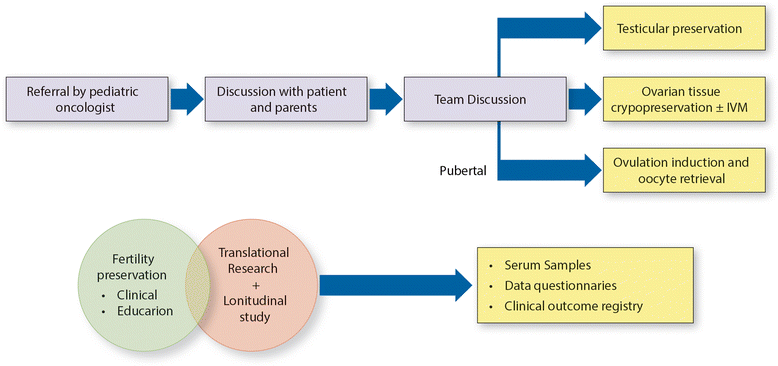Optimizing the process of fertility preservation in pediatric female cancer patients - a multidisciplinary program
- PMID: 27506811
- PMCID: PMC4979150
- DOI: 10.1186/s12885-016-2584-7
Optimizing the process of fertility preservation in pediatric female cancer patients - a multidisciplinary program
Abstract
Background: Current evidence indicates sub-optimal incidence of fertility preservation (FP) in eligible patients. We present herein our designated multidisciplinary program for FP in pediatric and adolescent population and present our data on FP in female patients.
Methods: Pediatric patients (age 0-18) who were candidate for highly gonadotoxic treatments were referred to FP program for a multidisciplinary discussion and gonadal risk-assessment followed by either oocyte cryopreservation or ovarian cryopreservation (OCP) for female patients, and sperm banking for male patients. The OCP protocol consists of aspiration of oocytes from small antral follicles and in-vitro maturation followed by cryopreservation, as well as ovarian tissue cryopreservation.
Results: The establishment of a designated FP program resulted in a significant increase in referral and subsequent FP procedures of all eligible patients. Sixty-two female patients were referred for FP discussion during a period of 36 months; 41 underwent OCP; 11 underwent oocyte cryopreservation and six were declined due to parental decision. The median age was 13.2y (range 18 months-18y). Thirty-two (51.6 %) were chemotherapy-naïve. Seventeen patients (27 %) had sarcoma, 16 patients (26 %) had acute leukemia. The mean number of mature oocytes that were eventually vitrified was significantly higher in chemotherapy-naïve patients compared with chemotherapy-exposed patients (mean 12 oocytes (1-42) versus 2 (0-7)).
Conclusion: Multidisciplinary programs that encompass experts of all relevant fields, skilled laboratory resources and a facilitated path appear to maximize the yield. We observed a considerable higher referral rates following launching a designated program and earlier OCP in chemo-naïve patients that culminated in a better fertility preservation procedure.
Keywords: Fertility preservation; Ovarian cryopreservation; Pediatric cancer patients.
Figures





References
-
- Feigin E, Abir R, Fisch B, Kravarusic D, Steinberg R, Nitke S, et al. Laparoscopic ovarian tissue preservation in young patients at risk for ovarian failure as a result of chemotherapy/irradiation for primary malignancy. J Pediatr Surg. 2007;42:862–4. doi: 10.1016/j.jpedsurg.2006.12.041. - DOI - PubMed
Publication types
MeSH terms
Substances
LinkOut - more resources
Full Text Sources
Other Literature Sources

